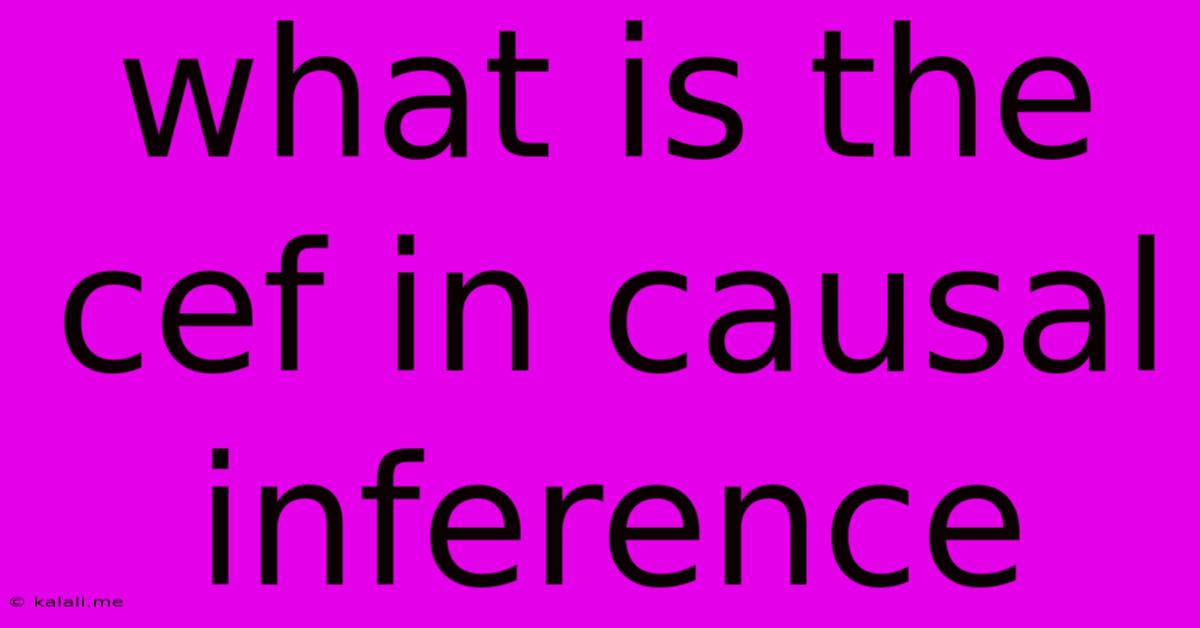What Is The Cef In Causal Inference
Kalali
May 31, 2025 · 3 min read

Table of Contents
What is the CACE in Causal Inference?
Meta Description: Understanding the Controlled Direct Effect (CACE) is crucial for causal inference. This article breaks down what CACE is, how it's calculated, and its practical applications, helping you navigate complex causal relationships.
Causal inference aims to understand the true causal effect of an intervention or treatment. In scenarios with mediating variables – variables that lie on the causal pathway between the treatment and the outcome – isolating the direct effect of the treatment becomes challenging. This is where the Controlled Direct Effect (CACE) comes in. CACE helps us understand the direct effect of a treatment on an outcome, controlling for the mediating variable. It's a powerful tool for disentangling complex causal relationships and provides a more nuanced understanding of treatment effects than simply looking at the total effect.
Understanding the Mediation Process
Before diving into CACE, let's clarify mediation. Imagine a scenario where we want to understand the effect of a new drug (treatment) on blood pressure (outcome). The drug might lower blood pressure directly, but it could also do so indirectly by reducing stress (mediator). The total effect of the drug on blood pressure includes both the direct and indirect effects. CACE specifically isolates the direct effect.
Defining CACE: The Controlled Direct Effect
CACE represents the effect of the treatment on the outcome if the mediator were set to a specific value. Crucially, this value is often set to what it would have been without the treatment. This counterfactual approach is key to CACE's power in disentangling direct and indirect effects. By controlling for the mediator's potential response to the treatment, we can isolate the treatment's pure direct impact.
Calculating CACE: A Simplified Illustration
Calculating CACE usually involves complex statistical models, often utilizing techniques like structural equation modeling or instrumental variables. However, a simplified conceptual illustration can help:
Imagine we have data on treatment assignment (T=1 if treated, T=0 if not), mediator (M), and outcome (Y). We could compare the outcome for those treated (T=1) when the mediator is set to its counterfactual value under no treatment (M<sub>T=0</sub>) to the outcome for those untreated (T=0) with the mediator at the same counterfactual value (M<sub>T=0</sub>). The difference between these two represents a simplified version of CACE.
Important Considerations: Real-world CACE calculation involves handling missing counterfactual data and employing robust statistical techniques to account for uncertainty.
Practical Applications of CACE
CACE has wide-ranging applications across various fields, including:
- Public Health: Evaluating the direct effect of a public health intervention while accounting for mediating factors. For example, understanding the direct impact of a smoking cessation program on lung cancer rates, while controlling for changes in diet.
- Economics: Analyzing the direct impact of a policy change while considering mediating variables like market adjustments or consumer behavior.
- Marketing: Assessing the direct effect of an advertising campaign on sales, separating it from indirect effects through brand awareness or customer satisfaction.
- Social Sciences: Investigating the direct impact of a social program on a particular outcome, accounting for mediating factors such as changes in individual behavior or social networks.
Conclusion: CACE for Deeper Causal Understanding
The Controlled Direct Effect (CACE) is a sophisticated tool in causal inference. By isolating the direct effect of a treatment while controlling for mediating variables, CACE provides a more precise and nuanced understanding of causal relationships than simpler analyses. While its calculation can be complex, the insights gained are invaluable in various fields for evaluating interventions and policies accurately. The nuances of CACE necessitate a solid grasp of causal inference principles and appropriate statistical techniques.
Latest Posts
Latest Posts
-
Sort Df By Value Of Row
Jun 01, 2025
-
What Is It Called When Someone Says Atm Machine
Jun 01, 2025
-
What Is The First Music Video
Jun 01, 2025
-
Hello How Are You Doing Today
Jun 01, 2025
-
Failed To Restart Ssh Service Unit Ssh Service Not Found
Jun 01, 2025
Related Post
Thank you for visiting our website which covers about What Is The Cef In Causal Inference . We hope the information provided has been useful to you. Feel free to contact us if you have any questions or need further assistance. See you next time and don't miss to bookmark.